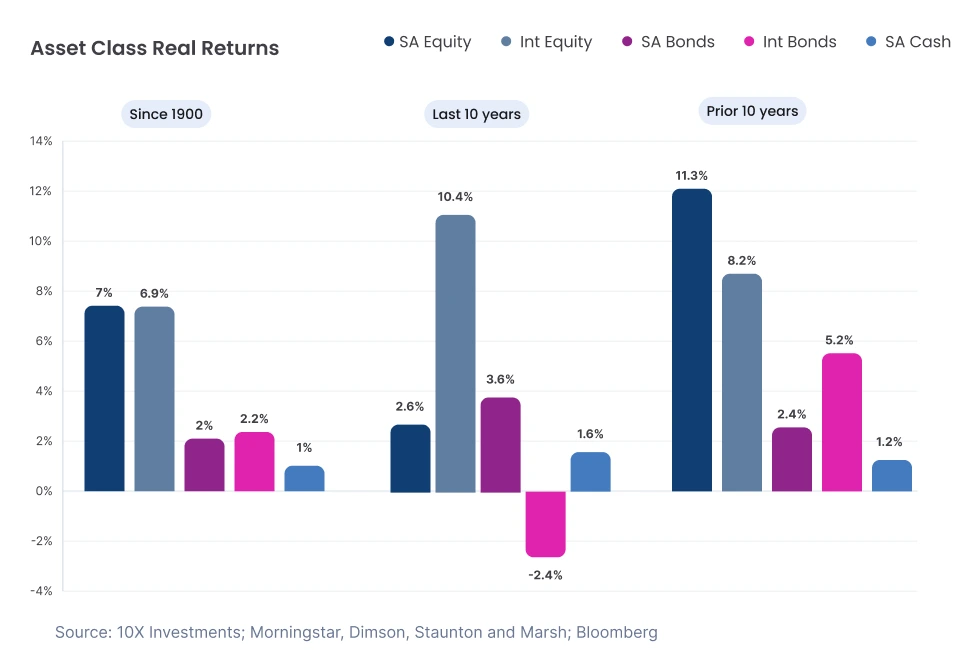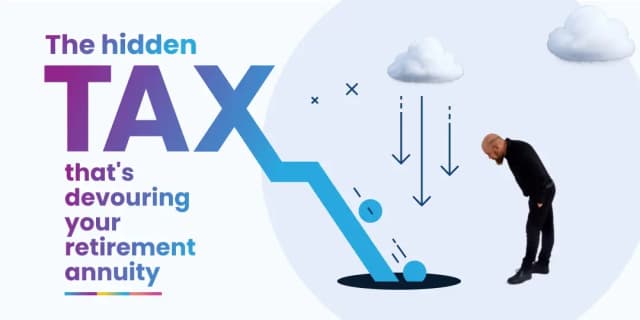The role of asset allocation in retirement annuity performance
22 August 2025
The uncomfortable truth about retirement in South Africa - Rands and Sense by 10X [video]
We sit down with 10X Investment Consultant lead Andre Tuck and discuss the retirement savings crisis in South Africa. We also delve into living annuities, retirement annuities, TFSAs and everything in between. Read more
![The uncomfortable truth about retirement in South Africa - Rands and Sense by 10X [video]](/_next/image?url=https%3A%2F%2Fimages.ctfassets.net%2Fyqvz0zwovkbq%2F5ipSTnRq5Dp25fyghm5kGQ%2F02c801c78d5e1ca9280bfd34d7602368%2FAndre_Tuck_podcast_cover_image__1_.webp&w=828&q=75)
A retirement annuity (RA) is a long-term retirement savings vehicle that accumulates funds before retirement, where those funds will be converted into either a living or life annuity (or a combination of both) to produce an income for said retirement. It is also flexible in certain aspects, as it allows you, as the investor, to select from carefully curated investment funds, each with a different asset allocation, where your savings will be invested.
Choosing a fund with the appropriate asset allocation is done according to your risk tolerance levels, time horizons and financial plan. The asset allocation can be a key determinant in the growth of the RA, so this must be managed efficiently. In this article, we will explore in more detail the importance of asset allocation, Regulation 28, understanding your risk tolerance levels and planning your RA.
Build the retirement of your dreams with our
Retirement Annuity calculatorWhat is a retirement annuity?
A retirement annuity is a popular choice among retirement savings vehicles, as it offers various tax benefits. Contributions to retirement annuities are tax-deductible, subject to annual limits. These are up to 27.5% of your income, or a maximum of R350 000.
Investment returns within the retirement annuity are also exempt from income tax, dividends tax and capital gains tax while invested. This means that there may be more of your returns available to be reinvested and allowed to potentially grow and compound over the long term. RAs also offer flexibility, as they allow you to adjust your regular contributions as your income needs change over time. You can contribute to a retirement annuity monthly via a regular debit order or, if you prefer, you are able to contribute ad hoc lump sum amounts (subject to the minimum amounts put in place by the service providers).
The rules regarding retirement product withdrawals were changed in September 2024 with the implementation of the Two-Pot Retirement System. This system now splits contributions between the ‘savings’ and ‘retirement’ pots. This is an effort to find a balance between financial security and accessibility of savings for emergencies. One-third of contributions will go to the ‘savings pot,’ and two-thirds of contributions will go to the ‘retirement pot.’
There is also a third partition, referred to as the ‘vested pot’. The vested pot applies to all contributions which were made prior to September 2024. The previous rules apply to this vested pot. As such, you are allowed one withdrawal prior to retirement from your vested pot.
See how the new system will impact your retirement savings
The savings pot allows for one withdrawal per year, for a minimum amount of R2000. If you choose to make a withdrawal, there will be an administration fee charged, and it will be taxed at your marginal tax rate. As always, it is best to keep your money invested and only withdraw in the event of an emergency. Upon retirement, the retirement pot will be used to purchase an annuity. Retirement age in South Africa is currently from age 55, but many stay employed for longer, often into their 60s. Please consult the FSCA guidance document for the most up-to-date information on the Two-Pot Retirement System.
What is asset allocation?
Asset allocation refers to the mix of underlying assets that your retirement annuity savings are invested in. This is mainly a mix of equities, bonds, real estate (property) and cash. As an investor, you have the freedom to adjust your underlying investment portfolio by choosing from a range of carefully designed funds, each with a different asset allocation. The asset allocation can be an important determinant of the success of your RA, so you always want to ensure that it is managed efficiently and effectively.
At 10X, we understand the importance of asset allocation, so we make sure to take an active approach to it whilst always looking for excellent returns for our clients over the long term. Find out more about our investment strategy here.

Asset classes typically available in a retirement annuity
As mentioned, the typical asset allocation will include a mix of equities, bonds, property (real estate) and cash. Each of the different asset classes has different features. Let’s look at these in more detail:
Equities: Equities are considered the most volatile of the asset classes, but typically, they may generate good returns. Data indicates that equities have historically produced returns above inflation by around 7% annually over the long term (based on JSE All Share Index performance versus CPI from 1960-2020) - however, past performance does not guarantee future results.
Bonds: Bonds add stability to a portfolio but may generate lower returns than those realised from equities.
Real estate: Real estate may generate some good returns and can also be a good hedge against inflation.
Cash: This is the least volatile of all the asset classes and the most liquid, but it will also realise the lowest returns.
We've built the 'happy retirement' machine
Understanding the most effective strategy for investing your retirement savings is fundamental to experiencing a happy retirement. We've built an investment machine that gives you a great chance of really golden years. Read more

Typically, you would look to diversify across the asset classes. This allows you to protect yourself against any potential losses in certain asset classes while also allowing you to take advantage of any good returns in other asset classes.
Including offshore exposure in your portfolio can also be a good hedge against local market instability and depreciation of the Rand. Of course, ensuring that you stick to Regulation 28 limits is paramount, which states that retirement annuities can allocate up to 45% of funds offshore.
Regulation 28 and its impact on retirement annuity allocations
Regulation 28 of the Pension Funds Act puts a limit on the percentage of your retirement annuity that you may invest in equities and offshore. This regulation has been put in place to help protect you, as an investor, and ensure that your portfolio is not poorly diversified.
Currently, you can invest 45% of your retirement money offshore and 75% of your retirement funds in equities. When selecting your asset allocation, it is important that you are aware of these limits and also that you adhere to these limits. All of the 10X Retirement Annuity funds are perfectly in line with Regulation 28 of the Pension Funds Act.
The relationship between asset allocation and risk in a retirement annuity
Each of the different asset classes has different levels of risk. As already mentioned above, you select your asset allocation by looking at factors such as your risk tolerance levels (your risk appetite) and your time horizons.
A more risk-tolerant investor will feel more comfortable with market volatility and any potential short-term losses in investment value that this may cause. As a more risk-tolerant investor with longer timelines, you may wish to include a higher percentage of equities in your portfolio. On the other hand, if you are a more risk-averse investor with shorter timelines at play, you may wish to include a higher percentage of bonds and/or cash in your portfolio for increased stability.
In summary, aligning your asset allocation with your profile as an investor is key to the long-term success of your RA. At 10X, we have a number of different funds within the retirement annuity wrapper. Each of these funds is suited to a different investor profile. No matter what your retirement goals are, 10X has a fund to suit you.
Adjusting your underlying investment portfolio as you age
Life stage investing looks at adjusting your asset allocation according to the life stage and age that you are at. You may have a higher tolerance for risk when you are younger, such as in your 20s and 30s, as you have more time before retirement and, therefore, more time to recover from any potential losses in capital that may occur.
This would mean you may like to include more growth-oriented assets, such as equities, in order to pursue potentially higher returns. In your 40s and 50s, you may prefer to switch to a more balanced portfolio, which includes both a mix of equities and bonds to pursue potential good returns while also including some stability in the portfolio to help preserve capital.
9 out of 10 people do better with 10X
As you move into your late 50s and early 60s, you may want to consider including a higher percentage of bonds and cash to aim for a more conservative, stable portfolio with the aim of safeguarding your capital. Keep in mind, even at this age, it could still be wise to include a percentage of equities in your portfolio, as this is likely to give you a better chance of outperforming inflation.
10X offers a wide range of carefully selected funds for your retirement annuity, each with a different mix of asset classes, allowing you the freedom to diversify across the different asset classes and make adjustments as you move into different stages of your life. If you would like to find out more information about what 10X has to offer, speak to one of the experienced and knowledgeable investment consultants.
The impact of fees on your RA
Another important, and often overlooked, factor that may impact the growth of your retirement annuity is the fees that you are paying. You need to be aware of the costs that are being deducted and, if possible, look to minimise high fees.
Compare your retirement investments
Effective annual cost calculatorLet’s look at the typical fees that you may see charged on your RA:
Administration fees: These are the fees charged for administration tasks so for example, tasks related to tax, compliance and reporting.
Advisor fees: These are the fees charged by an advisor for their advice and any other services. You may see both an initial and an annual fee charged by the advisor.
Management fees: These are the fees charged for the management of the fund.
Other fees: There may also be other applicable fees charged on certain products, such as an early exit fee.
As an investor, you should review the Effective Annual Cost (EAC) of your RA. This should be found on your statement, or you can request this from your service provider. The EAC is a metric which was implemented in 2015 by ASISA, referring to all of the fees and costs associated with your investment product over a one-year period of time.

All things being equal, a higher EAC may mean that there are fewer returns to be reinvested and allowed to grow over time compared to a lower EAC, which may mean that there are more returns available to potentially compound over the long term. There are a few factors to consider when comparing service providers; the EAC of an investment would be just one of these factors.
Let’s review the power of compound growth in action through an example.
In the first scenario, you start with a R100k lump sum and generate 6% real return (i.e. after fees and inflation) over 30 years. In the second scenario, you start with a R100k lump sum, and add just R1000 per month to it for 30 years at the same 6% real return.
In Scenario 1, you end up with roughly R482,000.
In Scenario 2, you end up with roughly R1.5 million.
We can see how even small contributions, when compounded, add up significantly over time.
Feel free to use our EAC calculator, which is part of a free online suite of tools offered by 10X. This EAC calculator will allow you to compare the EAC of an investment product with 10X with that of your current service provider, so you are able to compare and evaluate the fees and costs. Let’s take a deeper look at exactly how fees can impact your RA.
We’ll compare the fees of 3% with fees of 1%.
Investment period of: 30 years
Initial lump sum investment of: R50,000
Monthly contributions of: R2000
Return of 12% per annum
An inflation rate of 6%
Example 1 (1% Fees): Real investment value is approximately R1.8 million
Example 2 (3% Fees): Real investment value is approximately R1.3 million
Just a 2% difference in fees is equal to a difference of R500,000 in the long term. Higher fees have the potential to affect the growth of your RA, especially when compounded over the long term. You can learn more about the importance of fees here.
At 10X, we offer a transparent and low-cost fee structure. Most of the fees charged for our retirement products are 1% or less, depending on the product selected and the amount invested. For our most up-to-date fee information, please visit our website.
Final thoughts on how asset allocation impacts retirement annuity performance
Asset allocation is an important factor in the potential growth of your retirement annuity over the long term, so this should be carefully considered and planned. As you prepare for retirement, you should regularly review your asset allocation and ensure that the fund you selected still matches your risk tolerance levels, time horizons and financial goals.
If you find that your asset allocation is no longer aligning with your goals, a simple switch of funds may be necessary. Make sure you are also aware of the fees you are paying on your RA, and if you find these fees to be on the higher side, be sure to seek out other providers that may indeed be more cost-effective.
Speak to the highly qualified investment consultants at 10X to hear more about our cost-effective retirement annuity. With a 10X Retirement Annuity, more of your money goes to work for you. Get in touch today!
Related articles
How can we 10X Your Future?
Begin your journey to a secure future with 10X Investments. Explore our range of retirement products designed to help you grow your wealth and achieve financial success.


